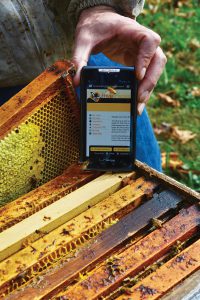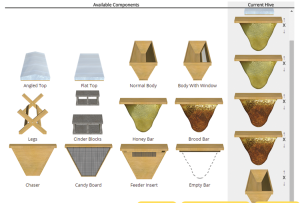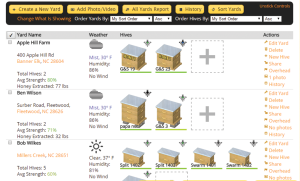By: James Wilkes
 Introduction
Introduction
Has this happened to you? You think it is about time to take a look at your bees; your internal bee alarm says it has been long enough since the last inspection to warrant getting in the hive again. You open up the hive, and they are a little noisier than usual and they are not boiling out of the top super like you were expecting given the current nectar flow. Your mind starts processing this input and given your knowledge of beekeeping, immediately you suspect something is amiss and continue your inspection. Digging further down in the hive you notice the bee numbers are much lower than expected and there are more drones than you like to see. As you reach the brood area it is becoming more and more clear that your hive is probably queenless or maybe they swarmed. At this point a vague memory comes into your mind about the last time you inspected this hive – it did not seem exactly right then even though you saw lots of bees and capped brood. Did you see the queen or eggs? You can’t remember. Back then you made a mental note that this hive needed to be monitored a little more closely, but as soon as you went to the next hive or the phone rang or you got stung on your finger, that mental note vanished until now, when the situation is much more challenging than if you had only remembered to follow up sooner. This has happened to me more times than I like to admit!
Knowing your bees is an essential component of successful and satisfying beekeeping. Knowing your bees includes understanding the current condition of your hive (use the word “colony” if you prefer) as well as remembering what the condition was last week, last month, last year, etc. Most of the beekeeping “know how” we strive for and accumulate as beekeepers is centered around observing a hive at varying levels of detail, making an assessment of its condition based on those observations, and choosing what to do or not to do based on that assessment. We read books, take classes, watch videos, talk to beekeepers, join online forums and of course, look at our hives. If you are diligent, it doesn’t take too long as a beekeeper before you can do a decent job of evaluating the basic current condition of a hive. However, as the opening story suggests, to be a successful beekeeper who stays ahead of and on top of the challenges of modern beekeeping, one must consider more than just the current condition of a hive in making hive management decisions. The history of the hive is equally important as is the context in which your bees live, things like weather, hive configuration, yard location including the forage environment and sun exposure, and even the purpose of the hive, pollination, honey production, or simply backyard enjoyment.
 Hive Tracks was designed and created to help you know your bees in the fullest sense as described above. By recording your observations, assessments, and actions, you will be equipped with the information you need to be a better beekeeper and you will enjoy greater satisfaction from your beekeeping by managing healthy and productive honey bee colonies. The remainder of this article provides an overview of the many helpful features of Hive Tracks, but the best way to evaluate it is to create an account and try it yourself!
Hive Tracks was designed and created to help you know your bees in the fullest sense as described above. By recording your observations, assessments, and actions, you will be equipped with the information you need to be a better beekeeper and you will enjoy greater satisfaction from your beekeeping by managing healthy and productive honey bee colonies. The remainder of this article provides an overview of the many helpful features of Hive Tracks, but the best way to evaluate it is to create an account and try it yourself!
Overview
Hive Tracks is software designed for beekeepers. It is a web application, which simply means you can access the Hive Tracks software through a web address, hivetracks.com, using any internet enabled device including smart phones, tablets, laptops, and desktops. Hive Tracks target beekeeper is the backyard and small sideliner, with active development of versions for larger sideliner and commercial beekeepers as well as bee researchers, bee producers, and queen producers and breeders. Hive Tracks provides an online platform for organizing information and data about your beekeeping endeavors and is organized in the same way you keep your bees. You have bee yards and within yards you have hives and for each hive you have a long list of characteristics and data about that hive. The system is not hard to understand because it reflects what you are already used to as a beekeeper.
 Yard View
Yard View
All beekeepers have one or more beeyards, locations where their bees reside. Hive Tracks users can create any number of bee yards. The “My Yards” page is one of the most popular ways to view the information in your account because it gives a high level summary of each yard in the system including the number of hives in the yard, the current weather, honey harvested, and average hive strength. Each beeyard location is based on an address and/or GPS coordinates. Characteristics of each yard can also be recorded, such as sun exposure, forage environment (agriculture vs. natural vs. urban), and purpose (pollination, honey production, home base, etc.). The location of each yard is marked by an icon on a google map (more on this later) that is private to the owner of the account. There is an option for a user to choose to show their yard location on a global map viewable by the Hive Tracks community of users. Interestingly, about 25% of the yards in the Hive Tracks system have been shared to the global map.
 Hive View
Hive View
Since the focal point for any beekeeper is the health and productivity of each colony, the bulk of information and data in Hive Tracks revolves around the hives, hence the name! The most basic information about a hive is a way to identify it, either a name you give it or a number, and its location. The simplest way to get this identifier on the hive out in the field is to write the name or number on the hive. Each hive also has a QR code associated with it if you want to be fancy and put the code on the hive and scan it with your phone. Additional information includes the original source of the bees in the hive, type of equipment used including the hive hardware configuration with a neat editor to configure the hive, queen information (age, marked?, clipped?, breed, description), and a beekeeper selected hive strength (we are working on making this a calculated value based on data). Within the Hive Tracks system, each hive is regarded as active or inactive with inactive hives serving as an archive of any hives that have been sold or given away or combined with other hives or died including the reason for death. The active/inactive state is useful for tracking seasonal losses.
 Inspections
Inspections
The heart of the Hive Tracks system is the ability to record observations, assessments, and management actions each time a hive is visited. Everyone has their own way of inspecting and managing their hives, so Hive Tracks is flexible to accommodate most any style and situation whether you are taking a quick look to assess honey flow or you are doing a full top to bottom evaluation. The inspection page was built based on the analysis of a variety of inspection sheets and includes more than most beekeepers want to record and also includes a free form text box for taking your own notes, which many people, myself included, like to do. The nice thing is that you only have to use the parts you want and ignore the rest (or customize the inspection, which we allow you to do!).
Following is a list of information in an inspection:
- time and date stamp
- notes – free text input that might include the reason for the inspection or any items not covered elsewhere
- weather conditions (automatic from an online service or you can record)
- queen sighted
- brood – eggs, capped, uncapped
- hive strength (beekeeper estimate based on observation)
- hive conditions – temper, population, queen cells, laying pattern, odor, etc.
- diseases present – choose from a list
- treatments applied – choose from a list
- honey and pollen stores available
- feeding applied – choose from a list
As you can see, there is a lot of ground covered though we are well aware that something you do might not be included! In that case, please let us know and use the text box to enter what you want to remember. Looking at this list also underscores the fact that there is no way you can remember all of this stuff from one inspection to the next much less from one season to the next.
 Google maps
Google maps
One of the most interesting and valuable features of Hive Tracks is a Google map with pins marking the location of each of your beeyards with concentric rings drawn at one mile, two mile, three mile intervals (or kilometers) around the yard showing the typical foraging area for bees from that yard. The initial pin location for a yard is based on the address of the yard and occasionally will not accurately reflect the actual location of your yard, so you can move the pin on the map to the exact location of your yard and the GPS coordinates are automatically updated. If you have not seen a satellite view of your beeyards, it can be an eye opening experience and very useful in evaluating available forage types and proximity to other beeyards, which is particularly helpful for queen breeding/rearing. In my own bee operation we seek out sourwood honey, and two of my sourwood yards are locations that an old beekeeper friend in my area had purchased in the 1950s specifically for making sourwood. Viewing these yards on the Google map clearly showed how the yards were ideally located in totally wooded sections of the downslope of the Blue Ridge Mountains. It was fascinating to see this and you will likely be surprised to see what your bees can reach.
There is More
What you have seen so far is simply a foundation and a framework of information and data that sets the stage for many valuable features and useful functionality that can only briefly be mentioned here due to space constraints. Maybe another article in the future will explore these in more depth! As your number of hives increase the volume of data entry escalates so we provide bulk operations that can apply to a group of hives: hive creation, inspection, moving, and requeening. Moving hives is worth mentioning because it is much easier to do in Hive Tracks than in real life. A simple cut and paste mechanism is used to select hives from one yard and put them into another yard. As mentioned already, you are given much flexibility in setting up your account and how your information is viewed including a variety of parameters for viewing your hives like queen age, date of last inspection, or you can order the hives like they are in the beeyard. Numerous preference settings include metric units for our international audience, customised inspections pages, alternate date formats, and several user interface controls.
Add to all of this a hive timeline, harvest records, reports, an online forum, a queen page and, you get the idea! Of course I have not even gotten to the really fun stuff that includes a hive hardware inventory, an integrated to do list and calendar with automatically generated to do list items, uploading of images, video, and audio, an offline native mobile app that works outside of cell and wifi coverage, and collective beekeeping analytics for your neighborhood, region, and the world. I almost forgot sharing information with your beekeeping friends: you can create groups (think bee clubs!) of Hive Tracks users who can share information with one another including a joint Google map.
Join the Club
My article last month discussed how Hive Tracks has grown organically around the world to include more than 14,000 beekeepers (crossed the 14K while I was writing this article!) in 139 countries. These beekeepers are taking an active step to be better beekeepers by equipping themselves with information and tools to make the best hive management decisions possible. I invite you to join them and me and the Hive Tracks community as we all endeavor to make the best of this great journey of beekeeping!
http://www.hivetracks.com
http://www.facebook.com/hivetracks
http://www.facebook.com/faithmtnfarm
james@hivetracks.com
James along with his wife and eight children keep bees in the vicinity of their family farm, Faith Mountain Farm, in the heart of the Blue Ridge Mountains of NC.






